Breaking the Chain... The Shootdown of Lt. Commander McCain over Hanoi 26 October 1967
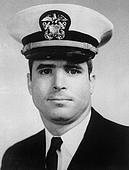 Like Grandfather, Like Father, Like Son... Like Grandfather, Like Father, Like Son...
The Navy was more than just in John S. McCain III's blood. Both McCain's grandfather and father were admirals in the United States Navy and, following in their footsteps, he attended the United States Naval Academy - graduating in 1958. He married in 1965, and became a naval aviator, flying attack aircraft from carriers. After working as an instructor in Mississippi, McCain earned himself an operational assignment in December of 1966. But on July 29th, 1967, at about 10:50 in the morning, while on board the USS Forrestal (CV-59), McCain narrowly escaped death when a Zuni rocket accidentally fired from a F-4 Phantom, jetted across the carrier's deck, and hit his A-4 Skyhawk, which was waiting to launch. 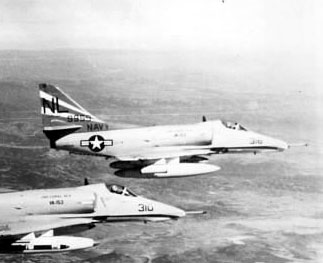 Evasive Action! Evasive Action!
McCain escaped from his burning jet, having clambered out over the refueling probe of his plane, and was trying to help another pilot escape when a bomb exploded; McCain was struck in the legs and chest by shrapnel. The ensuing fire killed 134 sailors, injured 161, and took 24 hours to control. As the Forrestal limped home for repairs, McCain called his father, then the Commander in Chief of all U.S. Navy forces in Europe, and volunteered to join the short-staffed USS Oriskany (CVA-34) to continue the fight in North Vietnam. Less than three months after the fire, on October 26, 1967, he launched in his A-4E "Skyhawk", Bureau #149959, attack aircraft as the number three aircraft in the first division of a strike group against the Hanoi Thermal Power Plant. As part of the Attack Squadron 163, it was McCain’s 23rd bombing mission over North Vietnam. 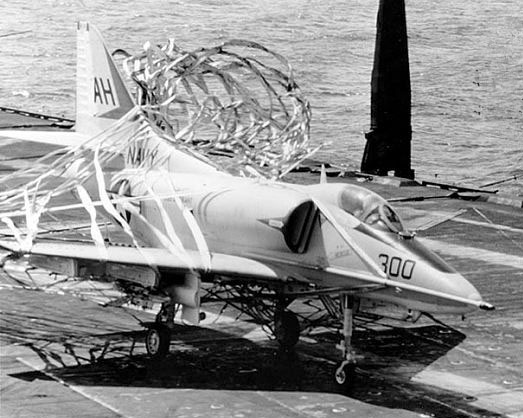 However, six days prior to McCain's flight, Lieutenant Junior Grade Denny Earl, with both legs shattered by North Vietnamese anti-aircraft fire, was forced to use the arresting barricade as he returned to land aboard the Oriskany. It is a foreshadowing of things to come for VA-163's plane bearing modex AH-300. However, six days prior to McCain's flight, Lieutenant Junior Grade Denny Earl, with both legs shattered by North Vietnamese anti-aircraft fire, was forced to use the arresting barricade as he returned to land aboard the Oriskany. It is a foreshadowing of things to come for VA-163's plane bearing modex AH-300.
McCain's flight met with considerable resistance in the form of anti-aircraft fire and surface-to-air missiles (SAM) approaching the target. As McCain rolled into his dive, his aircraft was observed by his wingman to take a direct hit by a Soviet-made SA-2! Direct Hit! As McCain recalled years after:” ... a missile the size of a telephone pole blew the right wing off the Skyhawk bomber... It went into an inverted, almost straight down spin. I was knocked unconscious by the force of the ejection. I did not realize it at the moment, but I had broken my right leg at the knee, my left arm and my right arm in three places.” Meanwhile, on the ground in downtown Hanoi, Mai Van On, a retired North Vietnamese Army colonel, was returning to his lakeside home on the shore of Truc Bach Lake for his lunch break as air-raid sirens sounded throughout the city. On rushed to join dozens of other people in a nearby bomb shelter, but noticed something: “I was at the entrance to the shelter, looking up at the sky, and I saw one plane hit by a missile. The tail was cut off, and it came down. I jumped out of the shelter. Others tried to prevent me from going out, saying it was too dangerous and cursing me, asking, `Why do you want to go out and rescue our enemy?'” The Golden Rule... 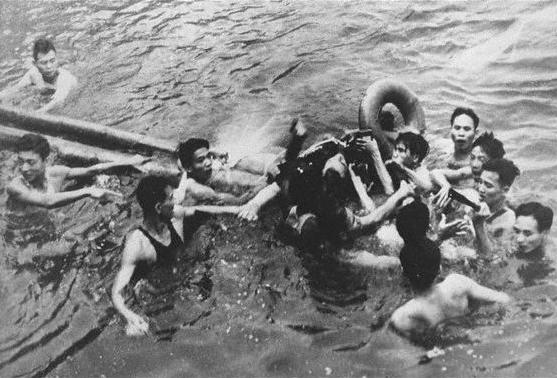 Ignoring the counsel of his countrymen, On grabbed a bamboo pole and swam 200 yards to the spot where McCain had splashed down into the lake - 16 feet deep. McCain recalled: “I regained consciousness as I parachuted into a lake right in the center of Hanoi. My helmet and oxygen mask had been blown off. With my fifty pounds of equipment and gear I sank to the bottom. I rose and then started sinking. I could not understand why I could not use my right arm or leg. The third time I sank I couldn't get back to the surface. With my teeth I was finally able to get the toggle released thus inflating the life preserver which floated me to the top.” Ignoring the counsel of his countrymen, On grabbed a bamboo pole and swam 200 yards to the spot where McCain had splashed down into the lake - 16 feet deep. McCain recalled: “I regained consciousness as I parachuted into a lake right in the center of Hanoi. My helmet and oxygen mask had been blown off. With my fifty pounds of equipment and gear I sank to the bottom. I rose and then started sinking. I could not understand why I could not use my right arm or leg. The third time I sank I couldn't get back to the surface. With my teeth I was finally able to get the toggle released thus inflating the life preserver which floated me to the top.”
On used his pole to untangle the ropes and pull the semi-conscious pilot to the surface. Seeing McCain in the water, On recalled, ``His head was drooping and his eyes were closed. They gradually opened, and I saw a look of relief that he was still alive.'' He gave McCain one end of the pole as he held the other and swam with one arm. Another North Vietnamese helped the pair to shore. On recollected that McCain's flight suit was torn, revealing a good-luck charm around his neck. Is it Luck?! 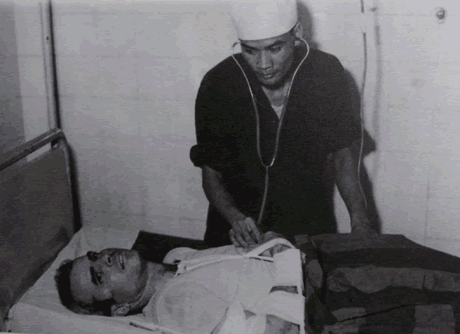 As the crowd of about 40 worked to strip away McCain's flight suit, he was kicked, punched, and spat upon by the mob. McCain noticed his right foot was askew to his left knee. He cried, "My God - my leg!" which further infuriated the assemblage. A bystander slammed a rifle butt down on McCain's shoulder, smashing it badly, and another individual stuck a bayonet in his foot. As the crowd of about 40 worked to strip away McCain's flight suit, he was kicked, punched, and spat upon by the mob. McCain noticed his right foot was askew to his left knee. He cried, "My God - my leg!" which further infuriated the assemblage. A bystander slammed a rifle butt down on McCain's shoulder, smashing it badly, and another individual stuck a bayonet in his foot.
On, still present in the gathering, called the mob to quiet, and McCain was assisted onto a stretcher, and handed over to the police, where his identify as the son of an American admiral was learned. He was then given medical attention at Ministry of Defense Hospital # 108, and taken to the Hoa Loa prison, as known as the “Hanoi Hilton” to the captured Americans interred there, to begin his stint as a Prisoner of War in the oppression of the North Vietnamese. McCain wrote in his autobiography that his hardships as prisoner of war included beatings, poor medical treatment for his injuries, and a total of three years in solitary confinement for what his captors called a "bad attitude." He twice tried to hang himself, using his shirt as a noose, but was caught by guards and beaten.
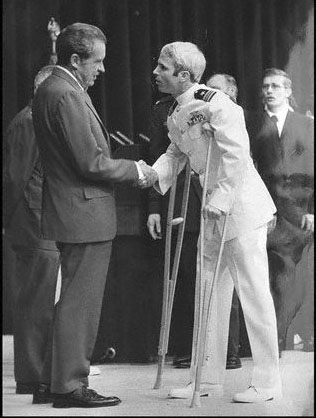 The Sands of Time... The Sands of Time... Due to his father's status as an admiral, McCain was offered early release, but refused - citing the American Fighting Man's Code of Conduct principle of "first in, first out": he would only accept the offer if every man taken in before him was released as well. McCain endured over five years of harsh, cruel treatment at the hands of the North Vietnamese, being released from captivity on March 15,1973. On May 24th, 1973, President Richard Nixon held a White House reception honoring the returning POWs, where an iconic photograph of Nixon shaking hands with McCain, in his full dress uniform, but still in crutches. On the western lake shore of Trúc Bạch Lake, on Thanh Niên Road, in Hanoi, a monument has been erected commemorating McCain's shootdown and capture. The inscription, roughly translated, reads: "Here on 26 October 1967 at Truc Bach Lake in the capital city of Ha Noi, John Sidney McCain was shot out of the sky in his A4 aircraft by local militia citizens defending Yen Phu. There were 10 other planes shot down on the same day." On the memorial, however, McCain is indentified as flying an Air Force plane, not a naval A-4. After returning to the U.S., McCain underwent extensive physical therapy in order to return to flying condition, which he did, taking command of Attack Squadron 174 in 1976, the same year he was appointed Navy liaison to the Senate. But McCain's physical injuries, and lack of ship command experience, ensured that his career would end there. He retired from the Navy in 1981, the recipient of the Silver Star, Bronze Star, Legion of Merit, Purple Heart, and the Distinguished Flying Cross. McCain moved to Arizona and entered politics. In 1982, he was elected to the U.S. House of Representatives from Arizona's 1st congressional district. After serving two terms there, he was elected to the U.S. Senate from Arizona in 1986. McCain was a candidate for the Republican nomination in the 2000 presidential election, but was defeated by George W. Bush, and won the party's 2008 nomination, losing in the general election to Barack Obama. |
